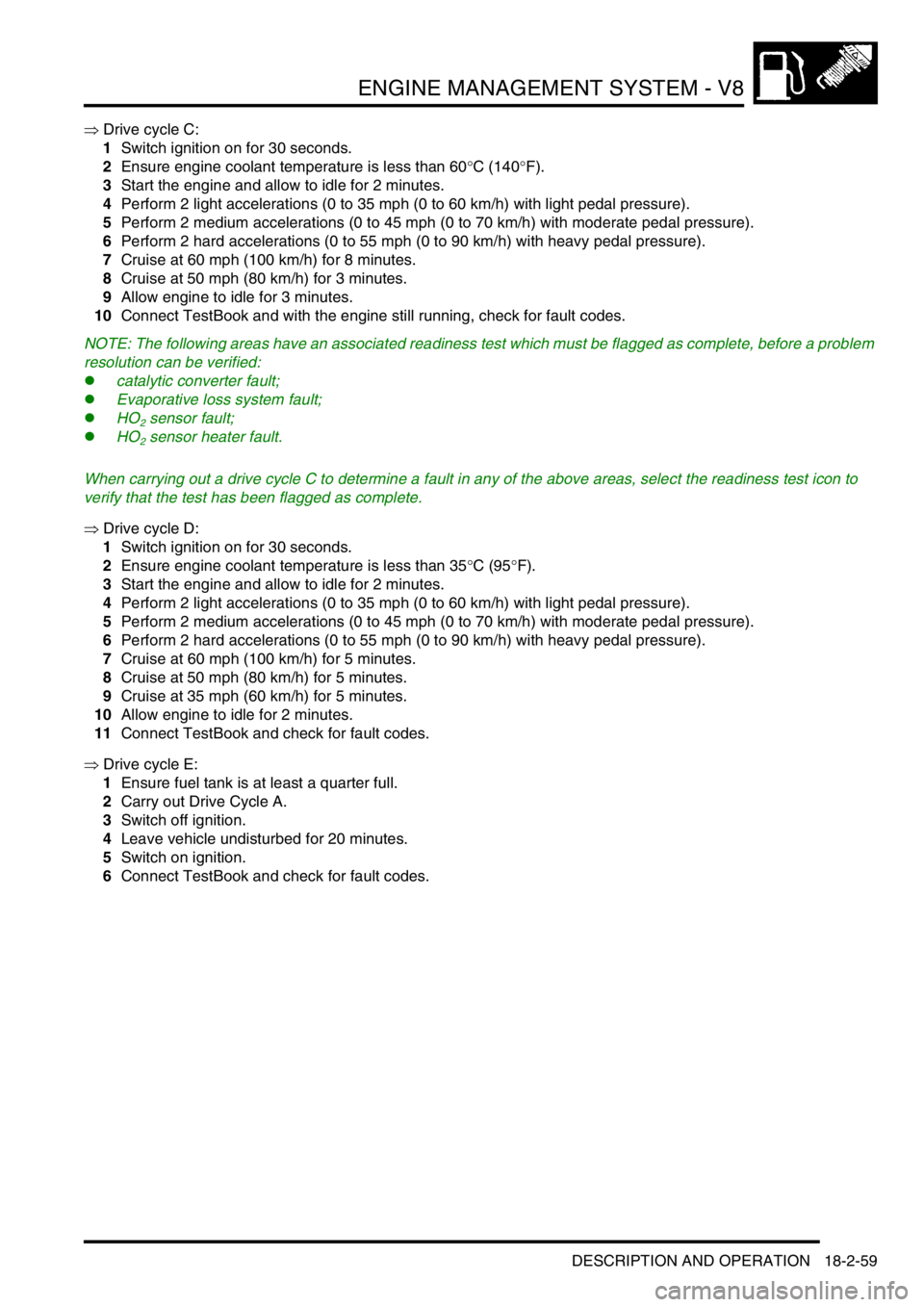ignition LAND ROVER DISCOVERY 1999 Service Manual
[x] Cancel search | Manufacturer: LAND ROVER, Model Year: 1999, Model line: DISCOVERY, Model: LAND ROVER DISCOVERY 1999Pages: 1529, PDF Size: 34.8 MB
Page 340 of 1529

ENGINE MANAGEMENT SYSTEM - V8
DESCRIPTION AND OPERATION 18-2-41
Input/Output
Input to the low tension side of the ignition coils comes from Fuse 14 located in the passenger compartment fuse box.
This fuse provides battery power for two ignition coils.
It is possible to test both primary and secondary coils of the ignition coils for resistance using a multimeter as follows:
lExpected primary coil resistance: 0.5 ± 0.05 Ω at 20 °C (68 °F).
lExpected secondary coil resistance: 13.3 ± 1.3 kΩ at 20 °C (68 °F).
The ECM provides the earth control for each coil on separate pins as follows:
LH Bank (cylinders 1, 3, 5, 7)
lCylinder 1 - pin 6 of connector C0638 of the ECM multiplug.
lCylinder 3 - pin 2 of connector C0638 of the ECM multiplug.
lCylinder 5 - pin 8 of connector C0638 of the ECM multiplug.
lCylinder 7 - pin 7 of connector C0638 of the ECM multiplug.
RH Bank (cylinders 2, 4, 6, 8)
lCylinder 2 - pin 2 of connector C0638 of the ECM multiplug.
lCylinder 4 - pin 7 of connector C0638 of the ECM multiplug.
lCylinder 6 - pin 6 of connector C0638 of the ECM multiplug.
lCylinder 8 - pin 8 of connector C0638 of the ECM multiplug.
The ignition coil can fail the following ways or supply incorrect signal:
lCoil open circuit.
lShort circuit to vehicle supply.
lShort circuit to vehicle earth.
lFaulty component.
In the event of ignition coil failure any of the following symptoms may be observed:
lEngine misfire on specific cylinders.
lEngine will not start.
Page 341 of 1529

ENGINE MANAGEMENT SYSTEM - V8
18-2-42 DESCRIPTION AND OPERATION
Knock Sensor (KS)
The ECM uses two knock sensors located between the centre two cylinders of each bank to detect pre-ignition. The
knock sensors consist of piezo ceramic crystals that oscillate to create a voltage signal. During pre-ignition the
frequency of crystal oscillation increases, which alters the signal output to the ECM. The ECM compares the signal
to known signal profiles in its memory. If pre-ignition is detected the ECM retards ignition timing for a number of cycles.
If no more pre-ignition is detected, the timing is gradually advanced to the original setting.
The ignition is calibrated to run on 95 RON premium fuel, but the system will run satisfactorily on 91 RON regular fuel.
If the vehicle is refuelled with a lower grade fuel, some audible detonation will initially be heard. This is non-damaging
and ceases when the system adaption is completed.
Input/Output
Because of the nature of its operation, the knock sensors do not require any electrical input source. The KS output
for LH bank (cylinders 1, 3, 5, 7) is measured via pin 49 of connector C0636 of the ECM. The KS output for RH bank
(cylinders 2, 4, 6, 8) is measured via pin 36 of connector C0636 of the ECM. Both knock sensors have a screened
earth to protect the integrity of the sensor signals. The KS earth for LH bank (cylinders 1, 3, 5, 7) is via pin 48 of
connector C0636 of the ECM. The KS earth for RH bank (cylinders 2, 4, 6, 8) is via pin 35 of connector C0636 of the
ECM.
The connector and sensor terminals are gold plated for corrosion and temperature resistance, care must be exercised
while probing the connector and sensor terminals.
The KS can fail the following ways or supply incorrect signal:
lSensor open circuit.
lShort circuit to vehicle battery supply.
lShort circuit to vehicle earth.
lFaulty component.
lIncorrectly tightened sensor.
In the event of a KS signal failure any of the following symptoms may be observed:
lKS disabled, the ECM refers to a 'safe ignition map'.
lRough running.
lEngine performance concern.
Page 342 of 1529

ENGINE MANAGEMENT SYSTEM - V8
DESCRIPTION AND OPERATION 18-2-43
The ECM performs the following diagnostic checks to confirm correct knock sensor operation:
lKS signal level is less than the minimum threshold (dependent on engine speed) – the engine must be running,
coolant temperature above 60°C (140°F), number of camshaft revolutions since start greater than 50 and the KS
signal profile must be less than the threshold value at a given engine speed for a fault condition to be flagged
lKS signal is greater than the maximum threshold (dependent on engine speed) – the engine must be running,
coolant temperature above 60°C (140°F), number of camshaft revolutions since start greater than 50 and the KS
signal profile must be greater than the threshold value at a given engine speed for a fault condition to be flagged
lError counter for verification of knock internal circuitry exceeded – the engine must be running, coolant
temperature above 60°C (140°F), number of camshaft revolutions since start greater than 50 and the error
counter greater than the threshold value at a given engine speed for a fault condition to be flagged
Should a malfunction of the component occur the following fault codes may be evident and can be retrieved by
TestBook:
Spark plugs
The spark plugs are platinum tipped on both centre and earth electrodes. The platinum tips give a long maintenance
free life.
Cleaning or resetting the spark plug gap is not recommended as this could result in damaging the platinum tips and
thereby reducing reliability.
The misfire detection system will malfunction and store erroneous codes if the incorrect spark plugs are used.
Input/Output
The ignition coils provide a voltage to the spark plugs via the ht leads. The cylinder head via the individual thread of
each spark plug provides the earth path.
The spark plugs can fail in the following ways:
lFaulty component.
lConnector or wiring fault.
lBreakdown of high tension lead causing tracking to chassis earth.
lIncorrect spark plugs fitted.
In the event of a spark plug failure, misfire on specific cylinder may be observed:
P Code J2012 Description Land Rover Description
P0327 Knock sensor 1 circuit low input (bank 1 or single
sensor)LH bank signal less than threshold determined from
ECM model above 2200 rev/min
P0328 Knock sensor 1 circuit high input (bank 1 or
single sensor)LH bank signal greater than threshold determined from
ECM model above 2200 rev/min
P0332 Knock sensor 2 circuit low input (bank 2) RH bank signal less than threshold determined from
ECM model above 2200 rev/min
P0333 Knock sensor 2 circuit high input (bank 2) RH bank signal greater than threshold determined from
ECM model above 2200 rev/min
Page 343 of 1529

ENGINE MANAGEMENT SYSTEM - V8
18-2-44 DESCRIPTION AND OPERATION
High tension (ht) leads
The ht leads are located on top of the engine, below the plenum chamber. Their function is to transfer the ht voltage
generated by the ignition coils to the spark plugs in the engine.
Input/Output
The input to the ht lead is ht voltage from the ignition coil pack. The ht lead then supplies this voltage to the spark
plug. Output ht voltage is used by the spark plugs to ignite the air/fuel mixture in the combustion chamber.
The ht leads can fail in the following ways:
lConnector/ Wiring fault.
lFaulty component causing spark tracking to chassis earth.
lDamage to ht leads during component removal.
In the event of a ht lead failure the following symptom may be observed:
lMisfire on specific cylinder.
All ignition system related faults are diagnosed by the misfire detection system and its fault codes.
Hill Decent Control (HDC)
Refer to Brakes for description of the hill descent control.
+ BRAKES, DESCRIPTION AND OPERATION, Description.
High/Low ratio switch
Refer to Transfer Box for description of the high/ low ratio switch transfer box components.
+ TRANSFER BOX - LT230SE, DESCRIPTION AND OPERATION, Description.
Page 344 of 1529

ENGINE MANAGEMENT SYSTEM - V8
DESCRIPTION AND OPERATION 18-2-45
Malfunction Indicator Lamp (MIL)/ service engine soon warning lamp
The MIL/ service engine soon warning lamp is located in the instrument cluster. It illuminates to alert the driver to
system malfunctions. Service engine soon warning lamp is the name for this warning lamp in NAS only, it is called
MIL in all other markets.
During ignition a self-test function of the lamp is carried out. The lamp will illuminate for 3 seconds then it will
extinguish if no faults exist.
+ INSTRUMENTS, DESCRIPTION AND OPERATION, Description.
Input/Output
The MIL is supplied with battery voltage from the instrument cluster. When the ECM detects a fault, it provides an
earth path to illuminate the MIL. Output to the MIL is via pin 20 of connector C0637 of the ECM.
Air Temperature Control (ATC) request
The ATC request comes via the ATC switch located in the facia panel. When the driver operates the switch it acts as
a request from the ATC ECU to engage the ATC clutch to drive the system.
During periods of high driver demand such as hard acceleration or maximum rev/min the ATC clutch will be disabled
for a short time. This is to reduce the load on the engine.
+ AIR CONDITIONING, DESCRIPTION AND OPERATION, Description.
Page 349 of 1529

ENGINE MANAGEMENT SYSTEM - V8
18-2-50 DESCRIPTION AND OPERATION
Conditions
To achieve closed loop fuelling, the ECM interacts with the following components:
lHO
2S.
lFuel injectors.
Closed loop fuelling is a rolling process controlled by the ECM. The ECM uses information gained from the CKP, ECT,
MAF/ IAT and the TP sensors, to operate under the following conditions:
lPart throttle.
lLight engine load.
lCruising.
lIdle.
Function
When the engine is operating in the above conditions, the ECM implements the closed loop fuelling strategy. The air/
fuel mixture is ignited by the high tension (ht) spark in the combustion chambers and the resulting gas is expelled into
the exhaust pipe. Upon entering the exhaust pipe the exhaust gas passes over the protruding tip of the HO
2S. The
HO
2S measures the oxygen content of the gas compared to that of ambient air and converts it into a voltage, which
is measured by the ECM.
The voltage signal read by the ECM is proportional to the oxygen content of the exhaust gas. This signal can then be
compared to stored values in the ECM's memory and an adaptive strategy can be implemented.
If the HO
2S informs the ECM of an excess of oxygen (lean mixture), the ECM extends the opening time of the fuel
injectors via the Injector Pulse Width (IPW) signal. Once this new air/ fuel ratio has been 'burnt' in the combustion
chambers the HO
2S can again inform the ECM of the exhaust gas oxygen content, this time there will be a lack of
oxygen or a rich mixture. The ECM reduces the opening time of the injectors via the IPW signal using the ECM's
adaptive fuel strategy. During closed loop fuelling the HO
2S will constantly switch from rich to lean and back again,
this indicates that the ECM and the HO
2S are operating correctly.
Open loop fuelling
Open loop fuelling does not rely on information from the HO
2S, but the air/ fuel ratio is set directly by the ECM, which
uses information gained from the ECT, MAF/ IAT, the TP sensors and also the vehicle speed sensor (VSS). The ECM
uses open loop fuelling under the following conditions:
lCold start.
lHot start.
lWide open throttle.
lAcceleration.
The ECM uses open loop fuelling to control fuel quantity in all non adaptive strategy conditions. The ECM implements
fuelling information carried in the form of specific mapped data contained within its memory.
Because there is no sensor information (e.g. HO
2S), provided back to the ECM, the process is called an 'open loop'.
The ECM will also go into open loop fuelling if a HO
2S fails.
Ignition timing
The ignition timing is an important part of the ECM adaptive strategy. Ignition is controlled by a direct ignition system
using two four-ended coils operating on the wasted spark principle.
When the ECM triggers an ignition coil to spark, current from the coil travels to one spark plug, then jumps the gap at
the spark plug electrodes, igniting the mixture in the cylinder in the process. Current continues to travel along the earth
path (via the cylinder head) to the spark plug negative electrode at the cylinder that is on the exhaust stroke. The
current jumps across the spark plug electrodes and back to the coil completing the circuit. Since it has simultaneously
sparked in a cylinder that is on the exhaust stroke, it has not provided an ignition source there and is consequently
termed 'wasted'.
Page 350 of 1529

ENGINE MANAGEMENT SYSTEM - V8
DESCRIPTION AND OPERATION 18-2-51
Conditions
The ECM calculates ignition timing using input from the following:
lCKP sensor.
lKnock sensors (KS).
lMAF sensor.
lTP sensor (idle only).
lECT sensor.
Function
At engine start up, the ECM sets ignition timing dependent on ECT information and starting rev/min from the CKP. As
the running characteristics of the engine change, the ignition timing changes. The ECM compares the CKP signal to
stored values in its memory, and if necessary advances or retards the spark via the ignition coils.
Ignition timing is used by the ECM for knock control.
Knock control
The ECM uses active knock control to prevent possible engine damage due to pre-ignition. This is achieved by
converting engine block noise into a suitable electrical signal that can be processed by the ECM. A major contributing
factor to engine 'knock' is fuel quality, the ECM can function satisfactorily on 91 RON fuel as well as the 95 RON fuel
that it is calibrated for.
Conditions
The ECM knock control system operates as follows:
lHot running engine.
l91 or 95 RON fuel.
Function
The ECM knock control uses two sensors located one between the centre two cylinders of each bank. The knock
sensors consist of piezo ceramic crystals that oscillate to create a voltage signal. During pre-ignition, the frequency
of crystal oscillation increases which alters the signal output to the ECM.
If the knock sensors detect pre-ignition in any of the cylinders, the ECM retards the ignition timing by 3° for that
particular cylinder. If this action stops the engine knock, the ignition timing is restored to its previous figure in
increments of 0.75°. If this action does not stop engine knock then the ECM retards the ignition timing a further 3° up
to a maximum of -15° and then restores it by 0.75° and so on until the engine knock is eliminated.
The ECM also counteracts engine knock at high intake air temperatures by retarding the ignition as above. The ECM
uses the IAT signal to determine air temperature.
Idle speed control
The ECM regulates the engine speed at idling. The ECM uses the idle air control valve (IACV) to compensate for the
idle speed drop that occurs when the engine is placed under greater load than usual. When the throttle is in the rest
position i.e. it has not been pressed, the majority of intake air that the engine consumes comes from the idle air control
valve.
IACV control idle speed
Conditions in which the ECM operates the IACV control idle speed is as follows:
lIf any automatic transmission gears other than P or N are selected.
lIf air conditioning is switched on.
lIf cooling fans are switched on.
lAny electrical loads activated by the driver.
Function
The idle air control valve utilises two coils that use opposing pulse width modulated (PWM) signals to control the
position of a rotary valve. If one of the circuits that supplies the PWM signal fails, the ECM closes down the remaining
signal preventing the idle air control valve from working at its maximum/ minimum setting. If this should occur, the idle
air control valve assumes a default idle position at which the engine idle speed is raised to 1200 rev/min with no load
placed on the engine.
Page 357 of 1529

ENGINE MANAGEMENT SYSTEM - V8
18-2-58 DESCRIPTION AND OPERATION
Conditions
The CAN system is used by the EAT ECU and the ECM for transmission of the following information:
lGearshift torque control information.
lEAT OBD information.
lMIL request.
lVehicle speed signal.
lEngine temperature.
lEngine torque and speed.
lGear selected.
lGear change information.
lAltitude adaptation factor
lAir intake temperature
lThrottle angle / pedal position
Function
The CAN system uses a twisted pair of wires to form the 'data bus' to minimise electrical interference. This method of
serial interface is very reliable and very fast. The information messages are structured so that each of the receivers
(ECM or EAT ECU) is able to interpret and react to the messages sent.
The CAN 'data bus' is directly connected between pin 36 of connector C0637 of the ECM and pin 16 of connector
C0193 at the EAT ECU, and pin 37 of connector C0637 of the ECM and pin 44 of connector C0193 at the EAT ECU.
The CAN system can fail in the following ways:
lCAN data bus wiring open circuit.
lCAN data bus wiring short circuit.
In the event of a CAN data bus failure any of the following symptoms may be observed:
lMIL illuminated after 2 drive cycles (NAS only).
lEAT defaults to 3rd gear only.
lHarsh gearshifts.
l'Sport' and 'manual' lights flash alternately.
Should a malfunction of the component occur the following fault codes may be evident and can be retrieved by
TestBook.
Drive cycles
The following are the TestBook drive cycles:
⇒ Drive cycle A:
1Switch on the ignition for 30 seconds.
2Ensure engine coolant temperature is less than 60°C (140°F).
3Start the engine and allow to idle for 2 minutes.
4Connect TestBook and check for fault codes.
⇒ Drive cycle B:
1Switch ignition on for 30 seconds.
2Ensure engine coolant temperature is less than 60°C (140°F).
3Start the engine and allow to idle for 2 minutes.
4Perform 2 light accelerations (0 to 35 mph (0 to 60 km/h) with light pedal pressure).
5Perform 2 medium accelerations (0 to 45 mph (0 to 70 km/h) with moderate pedal pressure).
6Perform 2 hard accelerations (0 to 55 mph (0 to 90 km/h) with heavy pedal pressure).
7Allow engine to idle for 2 minutes.
8Connect TestBook and with the engine still running, check for fault codes.
P Code J2012 Description Land Rover Description
P0600 Serial communication link malfunction CAN time out
P1776 Transmission control system torque interface
malfunctionEAT torque interface error
Page 358 of 1529

ENGINE MANAGEMENT SYSTEM - V8
DESCRIPTION AND OPERATION 18-2-59
⇒ Drive cycle C:
1Switch ignition on for 30 seconds.
2Ensure engine coolant temperature is less than 60°C (140°F).
3Start the engine and allow to idle for 2 minutes.
4Perform 2 light accelerations (0 to 35 mph (0 to 60 km/h) with light pedal pressure).
5Perform 2 medium accelerations (0 to 45 mph (0 to 70 km/h) with moderate pedal pressure).
6Perform 2 hard accelerations (0 to 55 mph (0 to 90 km/h) with heavy pedal pressure).
7Cruise at 60 mph (100 km/h) for 8 minutes.
8Cruise at 50 mph (80 km/h) for 3 minutes.
9Allow engine to idle for 3 minutes.
10Connect TestBook and with the engine still running, check for fault codes.
NOTE: The following areas have an associated readiness test which must be flagged as complete, before a problem
resolution can be verified:
lcatalytic converter fault;
lEvaporative loss system fault;
lHO
2 sensor fault;
lHO
2 sensor heater fault.
When carrying out a drive cycle C to determine a fault in any of the above areas, select the readiness test icon to
verify that the test has been flagged as complete.
⇒ Drive cycle D:
1Switch ignition on for 30 seconds.
2Ensure engine coolant temperature is less than 35°C (95°F).
3Start the engine and allow to idle for 2 minutes.
4Perform 2 light accelerations (0 to 35 mph (0 to 60 km/h) with light pedal pressure).
5Perform 2 medium accelerations (0 to 45 mph (0 to 70 km/h) with moderate pedal pressure).
6Perform 2 hard accelerations (0 to 55 mph (0 to 90 km/h) with heavy pedal pressure).
7Cruise at 60 mph (100 km/h) for 5 minutes.
8Cruise at 50 mph (80 km/h) for 5 minutes.
9Cruise at 35 mph (60 km/h) for 5 minutes.
10Allow engine to idle for 2 minutes.
11Connect TestBook and check for fault codes.
⇒ Drive cycle E:
1Ensure fuel tank is at least a quarter full.
2Carry out Drive Cycle A.
3Switch off ignition.
4Leave vehicle undisturbed for 20 minutes.
5Switch on ignition.
6Connect TestBook and check for fault codes.
Page 363 of 1529

ENGINE MANAGEMENT SYSTEM - V8
18-2-64 DESCRIPTION AND OPERATION
Cruise control master switch
The cruise control master switch switches the system on and off. When the cruise control master switch is on, an
LED within the switch illuminates. If the cruise control master switch is off, cruise control will not operate. The switch
provides a 12 Volt feed to the cruise control ECU.
The cruise control master switch is located on the instrument panel near the steering column.
Input/Output
The input from the cruise control master switch to the cruise control ECU is either a 12 Volts ignition feed or an open
circuit. 12 Volts indicates that the cruise control master switch is on and the system can be activated. An open circuit
indicates that the cruise control master switch is off and cruise control cannot be activated.
TestBook will not communicate with the cruise control ECU if the cruise control master switch is off.